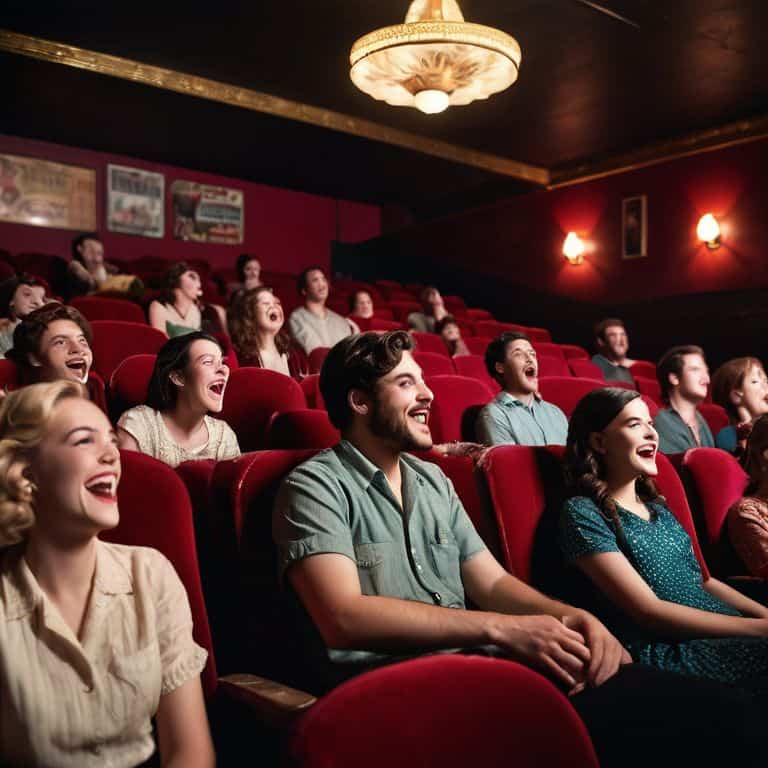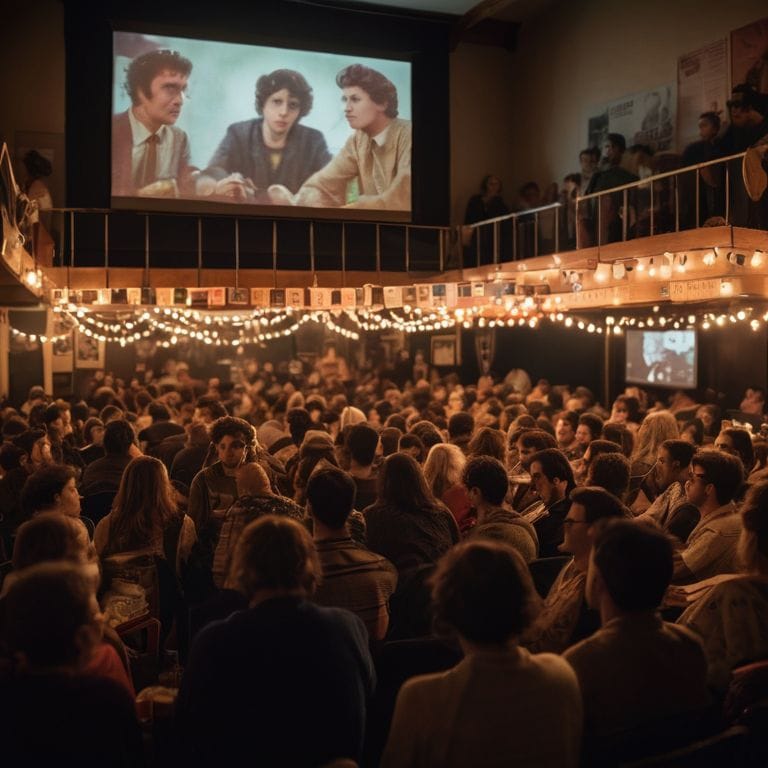I still recall the first time I watched Eraserhead in a cramped, smoke-filled screening room – the kind of experience that makes you wonder what makes a cult classic movie. It was the late 90s, and I was a music journalist, covering the indie scene. But it was films like Lynch’s surreal masterpiece that truly captured my attention, making me question the conventional wisdom that a movie needs to be mainstream to be memorable. The idea that a film’s popularity is directly tied to its commercial success is a myth that has always frustrated me.
As someone who’s spent years exploring the cultural undercurrents that shape our lives, I’ve come to realize that understanding what makes a cult classic movie requires a deeper dive. It’s not just about the film itself, but about the zeitgeist it captures, the anxieties and desires it reflects. In this article, I’ll cut through the hype and provide a no-nonsense exploration of the factors that contribute to a film’s cult status. I’ll draw from my own experiences, from the screening rooms to the academic halls, to offer a unique perspective on the subversive charm of cinema’s most beloved outcasts.
Table of Contents
What Makes a Cult Classic

As I delve into the defining characteristics of cult films, I’m struck by the role of nostalgia in their enduring popularity. It’s a peculiar alchemy that transforms a movie into a cult classic, often involving a dash of countercultural spirit and a healthy dose of irreverence. The economics of cult movie success are also fascinating, as these films frequently find their audience through word-of-mouth and midnight screenings, rather than traditional marketing channels.
The influence of cult classics on popular culture cannot be overstated, as they often subvert mainstream norms and challenge societal expectations. This, in turn, can lead to a devoted fan base that evangelizes the film to others, creating a snowball effect that propels the movie into cult status. Social media has also played a significant role in amplifying cult followings, allowing fans to connect with one another and share their passion for these beloved outcasts.
In the context of film festivals for cult cinema, it’s clear that these events provide a platform for like-minded individuals to come together and celebrate their shared love of outsider art. By examining the cultural significance of cult classics, we can gain a deeper understanding of the anxieties and desires that underpin our collective psyche, and perhaps even uncover the hidden forces that drive their enduring appeal.
Defining Quirks of Cult Films
As I delve into the world of cult classics, I’m struck by the offbeat charm that defines these films. They often feature unconventional narratives, memorable characters, and a healthy dose of irreverence. This unique blend of elements sets them apart from mainstream fare and fosters a devoted following.
The subversive spirit of cult films is another key aspect of their appeal. By challenging societal norms and pushing boundaries, these movies create a sense of excitement and rebellion among viewers. This willingness to take risks and defy expectations is a hallmark of cult classics, making them endure long after their initial release.
Nostalgias Role in Enduring Appeal
As I delve into the mystique of cult classics, I find myself pondering the significance of nostalgia in their enduring appeal. It’s a sentiment that transcends generations, evoking memories of midnight screenings and secret handshakes among fans. The nostalgia factor is a powerful force, allowing these films to become ingrained in our collective psyche.
The timeless quality of cult classics is, in part, due to their ability to evoke a bygone era, while still resonating with contemporary audiences. This unique blend of retro charm and relatable themes creates a sense of continuity, making it easy for new fans to discover and appreciate these beloved outcasts.
Cult Classic Economy and Influence

As we delve into the economics of cult movie success, it becomes clear that these films often thrive outside of traditional Hollywood metrics. Their influence can be seen in the way they’re screened and celebrated at _film festivals for cult cinema_, where fans gather to revel in their shared love of quirky, offbeat movies. These events have become a testament to the power of cult classics, allowing them to transcend their initial box office performance and find new life among devoted followers.
The influence of cult classics on popular culture cannot be overstated. From music videos to memes, these films have become a _cultural touchstone_, with references to them popping up in unexpected places. This phenomenon is, in part, driven by _how social media impacts cult followings_, allowing fans to connect and share their passion with others across the globe. As a result, cult classics have become a shared language, with fans using quotes, images, and scenes to communicate and bond with one another.
In this way, cult classics have created their own _alternative economy_, one that values nostalgia, irony, and a deep affection for the eccentric and unknown. By embracing these defining characteristics of cult films, fans have turned them into a cultural currency, trading in references and allusions that only make sense within their own unique community. As a result, cult classics continue to thrive, their influence spreading far beyond the screen to become a lasting part of our shared cultural heritage.
Economic Success and Cultural Significance
As I delve into the world of cult classics, I’m struck by the paradoxical relationship between economic success and cultural significance. Some films, like Fight Club, bombed at the box office only to become cultural touchstones later on. This phenomenon speaks to the complexities of measuring a film’s worth, where commercial failure can sometimes precede a lasting impact on popular culture.
The cultural cache of cult classics can be immense, with some films spawning entire subcultures and influencing countless other works of art. This is evident in the way that films like Eraserhead or The Rocky Horror Picture Show have become ingrained in our collective psyche, continuing to inspire new generations of artists and fans alike.
Social Medias Impact on Cult Followings
As I delve into the world of cult classics, I’m struck by how social media platforms have become a catalyst for rediscovering and reappreciating these films. The internet’s ability to democratize access to information has allowed cult followings to flourish in ways previously unimaginable.
The virality of memes has played a significant role in introducing cult classics to new audiences, often in unexpected and humorous ways, thereby cementing their places in popular culture.
Unpacking the Enigma: 5 Essential Elements of Cult Classic Movies
- Embracing the Outsider Spirit: Cult classics often thrive on their nonconformity, rejecting mainstream norms and embracing eccentricity, which in turn, fosters a deep sense of community among their devoted fans
- Time Capsule of Rebellion: These films frequently capture the zeitgeist of their era, encapsulating the anxieties, desires, and rebellious spirits of their time, making them enduring time capsules of cultural significance
- The Power of Quirky Storytelling: Unconventional narratives, memorable characters, and a dash of surrealism or dark humor can transform a movie into a cult phenomenon, as these elements spark watercooler discussions and obsessive fandom
- Beyond Mere Entertainment: Cult classics often transcend their role as simple entertainment, becoming cultural touchstones that reflect and influence societal attitudes, political climates, and personal identities, thus embedding themselves deeply within our shared cultural consciousness
- Nostalgia and Personal Connection: The emotional bond formed between a viewer and a cult classic can be incredibly strong, as these movies often serve as markers of personal history, evoking memories of first watches, shared experiences, and the passage of time, which in turn, cements their cult status
Key Takeaways from the Realm of Cult Classics
Cult classic movies often thrive on a unique blend of innovative storytelling, memorable characters, and a rebellious spirit that resonates deeply with their audiences, making them a staple of cinematic history
The enduring appeal of these films can be attributed to a complex interplay of nostalgia, social media influence, and economic factors, which collectively contribute to their cult status and continued relevance in popular culture
By examining the quirks, themes, and cultural impact of cult classics, we gain a profound insight into the societal anxieties, desires, and values of their time, offering a fascinating lens through which to understand our shared human experience and the power of cinema to reflect and shape our collective psyche
The Essence of Cult Classics
A cult classic is not just a film that has stood the test of time, but a cultural artifact that distills the essence of its era, capturing the rebellious spirits, anxieties, and desires of its audience in a way that transcends mere entertainment, becoming a timeless reflection of our collective psyche.
Julian Thorne
Beyond the Silver Screen: The Enduring Legacy of Cult Classics

As we’ve delved into the world of cult classic movies, it’s become clear that their appeal lies in a unique blend of quirky charm and rebellious spirit. From the defining quirks of cult films that set them apart from mainstream cinema, to the role of nostalgia in their enduring appeal, and the impact of social media on their cult followings, each element contributes to a rich tapestry that captivates audiences. The economic success and cultural significance of these films may vary, but their influence on popular culture is undeniable, reflecting and shaping our deepest anxieties and desires.
So, as we leave the midnight screening and step back into the bright lights of reality, let’s remember that cult classics are more than just films – they’re cultural touchstones that offer a glimpse into our collective psyche. They inspire us to think differently, to challenge the status quo, and to find beauty in the bizarre. As we continue to navigate the ever-changing landscape of modern cinema, let’s cherish these cinematic outcasts, for they remind us that true art lies in the unexpected, the unconventional, and the unapologetically weird.
Frequently Asked Questions
Can a movie be considered a cult classic if it was initially a mainstream success, but has since developed a devoted niche following?
I’d argue that a movie’s initial mainstream success doesn’t disqualify it from cult classic status. What matters is how it’s recontextualized and obsessed over by a niche audience, often in ways that subvert its original intent. Think of it as a film’s second life, where its mainstream appeal is merely the precursor to a deeper, more fanatical devotion.
How do cult classic movies reflect and influence societal attitudes towards outsiders and nonconformity?
Cult classics often immortalize outsiders and nonconformists, reflecting our collective fascination with rebellion and challenging the status quo. Films like ‘Eraserhead’ or ‘The Rocky Horror Picture Show’ don’t just mirror societal attitudes, but influence them, validating the experiences of misfits and shaping our perception of what it means to be an outsider.
What role does fan participation, such as fan art and fan fiction, play in sustaining and spreading the cult status of a movie?
Fan participation is the lifeblood of cult classics, breathing new life into films through fan art, fiction, and fervent discussions, essentially becoming co-creators in the cult phenomenon, blurring lines between consumer and creator.
